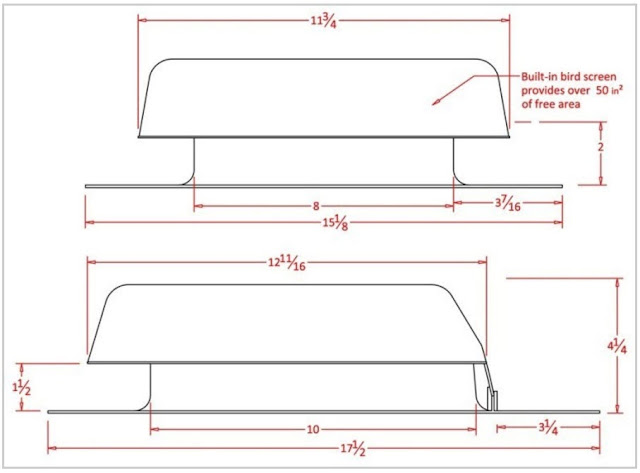I wonder what this means, to this possibility . We are reminded that RV038 may be fully disassembled from above, a plus. I am obliged to go back to my customer, to offer cleaning of his vent.
That customer did not wish for repair of this bath fan roof cap. A flex duct end had been positioned below the roof paper, and the fan never developed enough force to lift the cap flapper. Children grown. Fan not needed.
Look at this concentration of soffit vents at the base of a cathedral ceiling over the home grand staircase.
Here is one of the roof joist bays of that cathedral ceiling, open to the attic. Outside air entering the soffit openings is as likely to flow under the silly ill-fitting R19 batt, as over it. The ceiling is not insulated.
Here I have taken down a T12 two-dead-bulb fluorescent fixture in a walk-in closet.
Remember: tubes were black.
To wire the fluorescent fixture, detachable sides in two can lights were - - detached. Where the fixture roof sagged from two screws, this left large openings from the closet to the attic, with conditioned air well-enjoyed by spiders.
Where I replaced the cans and fixture with RACO 175 junction boxes and wonderful Nicor DLS10 LED disk lights, I could insert a very-wonderful Fakro LTK 22/47 ladder between. Note RACO 175 junction boxes ringed by drywall cut from the ladder opening, sealed in and texture-matched with my flexible grout .
LED disk lights are so much brighter, such pretty jewels, that will serve on forever. Brightest-possible light is wished in a closet.
A home inspector barely managed to arrest a bad fall, hanging onto the truss elements at RHS, making for that distant furnace pad. There were things to be fixed, identified in the inspector's photo report. Strange trusses missed connectors that might resist collapse roll-over if flimsy OSB sheathing, weakened at large high-vent cutouts, should buckle in a high-wind event. One could not safely get to the attic furnace. The inefficient home with crummy HVAC ducts in attic and crawl space effectively not insulated, needed two furnaces.
I made it to the furnace pad OK, not trusting the springy OSB for hanging-on, in a foot thrust to the revealed 2x4 bottom truss element. I swung along that RHS truss line. I expected to find no insulation under the 30 sq ft furnace pad. Instead I found this. Pad framing is perpendicular to trusses, and batts within that framing rest atop truss bottom elements, out of contact with drywall and of no value. How shameful! Who would not understand this?
I got home safely, 63 miles round-trip and most of a day invested. I offered clever blocking of truss roll-over, and a 200 sq ft strong plywood-decked pad, insulated R49, bridging the access hole and a jacked-up furnace, for modest $1250. I never heard from the mean realtor representing the seller and wanting cheapest repairs.















